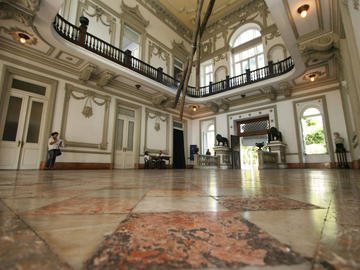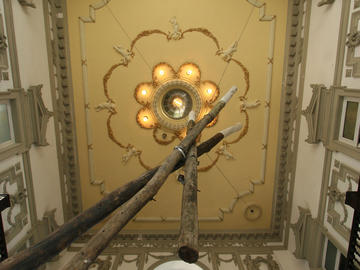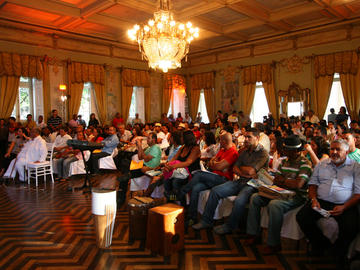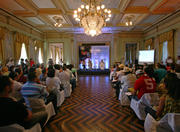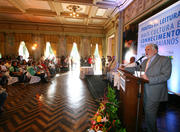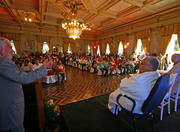Aclamação Palace Picture 1
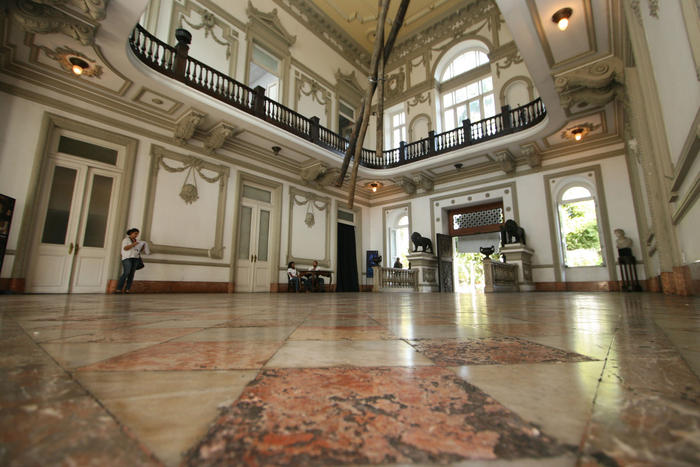
More information on Aclamação Palace in Salvador Bahia Photo by: Fotos Gov/Ba
Aclamação Palace in Salvador Bahia
The building of the Palace of Acclamation, built at the beginning of last century, was restored in the 90's and became a museum and "ceremonial house," reserved for parties. Yet who passed through its doors via Avenida Sete iron and wood and glass windows always closed.
That time is over. The palace, which completes 90 years with a series of events this Thursday through Saturday, is already receiving an average of 600 visitors per month. "People will identify, meet an impressive space," says museum director of the Institute of Artistic and Cultural Heritage (IPAC), Ana Liberato. She finds essential to give access to the public to know the building, which represents a time.
Students from schools and stakeholders in general are impressed with the luxury and care of the furniture style Louis XV and Don Jose, the floor planking, from wall paintings by the artist Prisciliano Silva - framed panels, garlands, bows and medallions - with the spacious balconies overlooking the Bay of All Saints and Public Road, and even the height of the walls. Rodrigo Marques Silva, 14, resident of the Call-Call, was delighted with the immensity of the place. "It should be very good to live here," he said.
Although purchased in 1911, the palace became the home of governors after a bomb struck the Rio Branco Palace, which was the official residence. So, Governor Seabra moved there and tried to initiate a reform that was completed only in the government of Moniz de Aragao, in 1917. Hence the celebrations for 90 years, starting today.
HISTORY
"The Palace of Moraes' Square in acclamation, belonged to Michael Francis Moraes, a successful merchant. When he died in 1895, the palace passed to his widow, Clara Cesar de Moraes, who remained there until 1911. That year, Mrs. Clara sold the property to the state for thirty contos. The official residence of the governors was, from 1908, the Rio Branco Palace, which is currently occupied by Pedro Calmon and Cultural Foundations.
The Palace of acclaim is the result of a political situation. It was the end of the government of João Ferreira de Araujo Pinho, who, pressed, resigns, citing "health", five months before completing his term. There was a fierce dispute over the government. It was when there was the bombing on 10 January 1912. The shots struck the Rio Branco Palace, and with it the offices were transferred to the Palace of acclamation, later elevated to the status of residence of the governors.
For the expansion of the house Moraes, JJ used a part of the Public Road. At the time, this was considered an encroachment. The first term ended in 1916 Seabra, without the works of the palace had finished. Antonio Moniz Sting promoted the continuation of Aragon in his administration, so the official residence was moved to the "Palace of Mercy", now headquarters of the Secretariat of Public Security of Bahia. On 3 November 1917, Moniz de Aragao returns to the Palace of acclamation. Seabra also return, in his second term as governor.
Palácio da Aclamação
http://www.atarde.com.br/cidades/noticia.jsf?id=808630
More Photos of Aclamação Palace Picture 1
